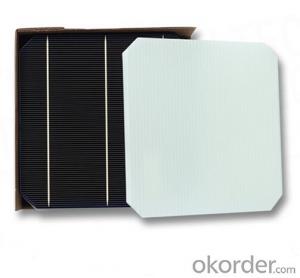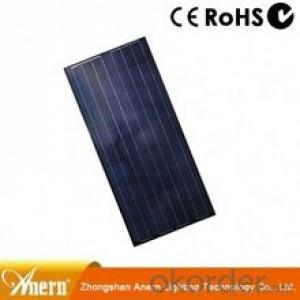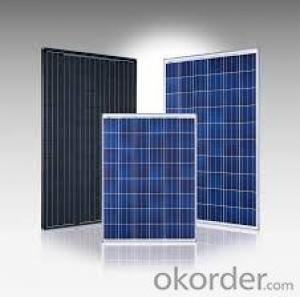Monocrystalline Solar Cells A Grade 18.2%
- Loading Port:
- Shanghai
- Payment Terms:
- TT OR LC
- Min Order Qty:
- 5000 pc
- Supply Capability:
- 800000 pc/month
OKorder Service Pledge
OKorder Financial Service
You Might Also Like
Brief Introduction of Solar Cells
A solar cell, is an electrical device that converts the energy of light directly into electricity by the photovoltaic effect, which is a physical and chemical phenomenon. It is a form of photoelectric cell, defined as a device whose electrical characteristics, such as current, voltage, or resistance, vary when exposed to light. Solar cells are the building blocks of photovoltaic modules, otherwise known as solar panels.
Advantage of Monocrystalline Solar Cells
1. Tire-1 Solar Cells’ Manufacturer Quality Guarantee. With a complete and sophisticated quality government system, our Quality Management have arrived world’s leading place. Customer can receive Tire-1 Cells Maker’s Quality Standard Products.
2. Trusted Warranty. We can supply trusted after-sales service to our customer. If our cells are found not in conformity to the specification of manufacturer, or should the inspected quantity found in shortage, or should the packing found damaged, the buyer has the right to claim to the seller. The claim, if any, should be presented to seller within 30 days after cargo's arrival date to the port, together with related inspection report and photos issued and provided by a reputable independent surveyor such as SGS.
3. World’s Leading Manufacturer Equipment. We imported the newest and leading production equipment from abroad. Advanced equipment can guarantee the stable quality of cells. Auto production line can also save labor cost which will further cut our production cost.
Specifications of Polycrystalline Solar Cells
Format : 156 mm × 156 mm ± 0.5 mm
Thickness: 210 μm ±40 μm
Front (-) : 1.5mm bus bars (silver),blue anti-reflection coating (silicon nitride)
Back (+) : 2.5mm wide soldering pads (silver) back surface field (aluminium)
Efficiency (%) Pmpp (W) Umpp (V) Impp (A) Uoc (V) Isc (A) |
18.20% 4.43 0.536 8.263 0.634 8.712 |
18.00% 4.38 0.535 - 8.188 0.633 8.701 |
17.80% - 4.33 0.534 - -8.112 ---0.632 ----8.652 |
17.60% 4.28 0.533 8.036 0.631 8.641 |
17.40% 4.23 0.529 8.005 0.630 8.591 |
17.20% 4.19 0.525 7.973 0.627 8.542 |
17.00% 4.14 0.522 7.926 0.624 8.495 |
16.80% 4.09 0.518 7.893 0.620 8.452 |
16.60% 4.04 0.515 7.844 0.617 8.410 |
16.40% 3.99 0.514 7.765 0.616 8.373 |
16.20% 3.94 0.511 7.715 0.615 8.317 |
16.00% 3.89 0.509 7.650 0.613 8.251 |
Usage of Monocrystalline Solar Cells
Solar cells are often electrically connected and encapsulated as a module. Photovoltaic modules often have a sheet of glass on the front (sun up) side, allowing light to pass while protecting the semiconductor wafers from abrasion and impact due to wind-driven debris, rain, hail, etc. Solar cells are also usually connected in series in modules, creating an additive voltage. Connecting cells in parallel will yield a higher current; our solar cells have passed IEC Certification. With high and stable quality, our cells can greatly improve the performance of Solar Modules.
Applications of Monocrystalline Solar Cells
Assemblies of photovoltaic cells are used to make solar modules which generate electrical power from sunlight, as distinguished from a "solar module" or "solar panel". A solar array generates solar power using solar energy.
Packaging & Delivery of Monocrystalline Solar Cells
Carton Box Package and Deliver by air. It should be noticed that it should be avoid of water, sunshine and moist.
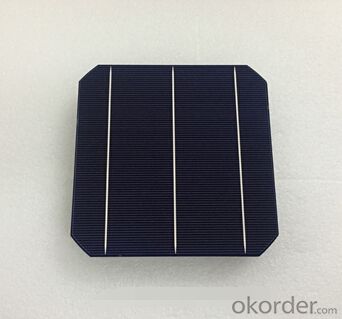
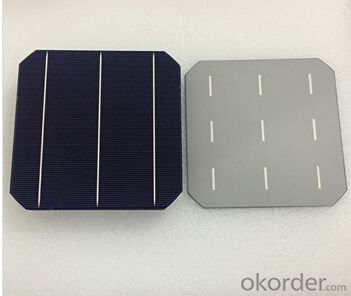
FAQ
We have organized several common questions for our clients,may help you sincerely:
①What price for each watt?
It depends on the efficiency of the solar cell, quantity, delivery date and payment terms.
②How long can we receive the product after purchase?
In the purchase of product within three working days, We will arrange the factory delivery as soon as possible. The pecific time of receiving is related to the state and position of customers.Commonly 7 to 10 working days can be served.
③Can you provide the peripheral products of the solar panels, such as the battery, controller, and inverter? If so, can you tell me how do they match each other?
Yes, we can, we have two companies for solar region, one is CNBM International, the other is CNBM engineering Co.
We can provide you not only the solar module but also the off grid solar system, we can also provide you service with on grid plant.
④What is your warranty of solar cell?
Our product can promise lower than 0.3% open box crack, we support claim after opening the box if it has crackm color difference or sth, the buyer should give pictures immediately, we can not accept the claim after the solar cell has assembled to solar panel.
• Timeliness of delivery
• ⑤How do you pack your products?
We have rich experience on how to pack the solar cell to make sure the safety on shipment, we could use wooden box or pallet as buyer's preference.
⑥ Can you do OEM for us?
Yes, we can.
- Q:What is the effect of wind on solar cell performance?
- The effect of wind on solar cell performance can be both positive and negative. On one hand, a gentle breeze can help to cool down the solar panels, preventing them from overheating and improving their overall efficiency. On the other hand, strong winds can create vibrations that may lead to structural damage or reduce the stability of the solar panels, potentially affecting their performance. Therefore, it is important to strike a balance between the benefits of cooling and the risks associated with excessive wind exposure when designing and installing solar systems.
- Q:How do solar cells perform in areas with high levels of air pollution and dust?
- Solar cells perform less efficiently in areas with high levels of air pollution and dust. The particles in the air and dust settle on the surface of the solar cells, reducing their ability to absorb sunlight and convert it into electricity. This buildup of dirt can significantly decrease the overall performance and output of the solar panels. Regular cleaning and maintenance are crucial in such areas to ensure optimal functioning of the solar cells.
- Q:Are solar cells affected by temperature?
- Yes, solar cells are affected by temperature. High temperatures can cause a decrease in the efficiency of solar cells, resulting in a decrease in their power output. This is due to the fact that the performance of the semiconductor materials used in solar cells can degrade at elevated temperatures. Additionally, temperature variations can also lead to thermal stress, which can impact the structural integrity of the solar cells.
- Q:Are solar cells affected by electromagnetic interference?
- Yes, solar cells can be affected by electromagnetic interference (EMI). EMI refers to the disturbance caused by electromagnetic radiation on electronic devices, including solar cells. The interference can lead to reduced efficiency and performance of the solar cells. Shielding techniques and proper grounding can be employed to mitigate the impact of EMI on solar cells.
- Q:What is the role of bypass diodes in solar cell systems?
- The role of bypass diodes in solar cell systems is to prevent the loss of power due to shading or damage to individual solar cells. These diodes provide an alternate pathway for the flow of current, allowing the unaffected cells to continue generating electricity even if some cells are blocked or not functioning optimally. By minimizing the impact of shading or cell failure, bypass diodes help to maintain the overall efficiency and performance of the solar cell system.
- Q:How do solar cells handle dust storms or sandstorms?
- Solar cells are designed to handle dust storms or sandstorms by utilizing various protective measures. These measures include coating the surface of the solar panels with specialized materials that repel dust or sand, installing self-cleaning mechanisms that automatically remove any accumulated particles, and positioning the panels at an angle to allow the wind to blow away the dust. Additionally, regular maintenance and cleaning of the solar panels are essential to ensure optimal performance during such weather conditions.
- Q:What is the impact of bird droppings on solar cell performance?
- Bird droppings can significantly impact solar cell performance by reducing the amount of sunlight reaching the surface of the cells. The droppings can act as a physical barrier, blocking sunlight and reducing the efficiency of the solar cells in converting sunlight into electricity. Additionally, the chemical composition of bird droppings can cause corrosion and damage to the surface of the cells, further degrading their performance over time. Regular cleaning and maintenance are essential to ensure optimal solar cell efficiency and prevent any long-term negative impact from bird droppings.
- Q:Can solar cells be used to power off-grid cabins or homes?
- Yes, solar cells can be used to power off-grid cabins or homes. Solar panels can generate electricity by converting sunlight into usable energy, which can then be stored in batteries for use during periods of low sunlight or at night. This makes solar power an ideal and sustainable solution for off-grid living, providing a reliable source of electricity without the need for a traditional power grid connection.
- Q:Can solar cells be used in electric bikes or scooters?
- Yes, solar cells can be used in electric bikes or scooters to harness the sun's energy and convert it into electricity to power the vehicles. By incorporating solar panels, these vehicles can become more sustainable and reduce their dependence on traditional energy sources.
- Q:Can solar cells be used for powering outdoor surveillance systems?
- Yes, solar cells can be used for powering outdoor surveillance systems. Solar cells convert sunlight into electricity, making them an ideal and sustainable power source for outdoor surveillance systems that require continuous operation. By harnessing solar energy, these systems can operate independently without the need for a grid connection or frequent battery replacements. Additionally, solar-powered surveillance systems are environmentally friendly and cost-effective in the long run.
1. Manufacturer Overview |
|
|---|---|
| Location | |
| Year Established | |
| Annual Output Value | |
| Main Markets | |
| Company Certifications | |
2. Manufacturer Certificates |
|
|---|---|
| a) Certification Name | |
| Range | |
| Reference | |
| Validity Period | |
3. Manufacturer Capability |
|
|---|---|
| a)Trade Capacity | |
| Nearest Port | |
| Export Percentage | |
| No.of Employees in Trade Department | |
| Language Spoken: | |
| b)Factory Information | |
| Factory Size: | |
| No. of Production Lines | |
| Contract Manufacturing | |
| Product Price Range | |
Send your message to us
Monocrystalline Solar Cells A Grade 18.2%
- Loading Port:
- Shanghai
- Payment Terms:
- TT OR LC
- Min Order Qty:
- 5000 pc
- Supply Capability:
- 800000 pc/month
OKorder Service Pledge
OKorder Financial Service
Similar products
New products
Hot products
Hot Searches
Related keywords
